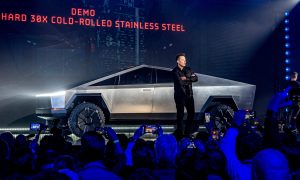

Investor's Corner
Leaked Tesla Gigafactory 3 photo shows ongoing Model 3 trial assembly runs
It appears that Tesla has started conducting trial assembly runs of its Model 3 sedan in Gigafactory 3. The recent update comes through a leak posted in Chinese social media platform Weibo, which depicted a partially-built white and blue Model 3 passing through a section of the Shanghai-based facility’s assembly lines.
The recently leaked image was shared by Weibo user 常岩, a prolific blogger and the chief auto editor of Tencent Auto, who wrote in his post’s description that “The Model 3 of the Tesla Shanghai plant has started to go up the assembly line.” It should be noted that this recent update marks the first time images of painted Model 3 units were seen within Gigafactory 3.
The implications of the recent leak are encouraging for Tesla, whose goal of starting Model 3 production this year is starting to become more and more realistic. The recent leaks from Gigafactory 3 suggest that the facility’s lines are coming together, after all, and there will likely be very little that could get in the way of the Model 3 being produced in mass quantities at the site in the near future.
Amidst the recent leak, reports from the EV community in China are suggesting that the first batch of Made-in-China Model 3 will start deliveries sometime in November. This is perfectly in line with the company’s estimates when it opened pre-orders for the Made-in-China Model 3 at the end of May, which suggested that first deliveries of the all-electric sedan will begin 6 to 10 months later. November marks the 6th month since pre-orders for locally-made Model 3 were opened in the country.
Perhaps more interestingly, reservation holders of the Made-in-China Model 3 have begun seeing tutorials for their ordered vehicles in their Tesla mobile app. The reasons behind this remain unannounced for now, but it is difficult to imagine Tesla rolling out tutorials to its Made-in-China Model 3 customers if the vehicle was still far from entering initial production.
Rather amusingly, these recent leaks and reports emerged from China just days after US-based firm JL Warren Capital estimated that Gigafactory 3’s Model 3 ramp will be slow, with the complex only hitting a production rate of 1,000-2,000 vehicles per week by the middle of 2020, around nine months from now. Considering that the majority of Gigafactory 3’s entire Phase 1 construction only took over eight months from muddy field to a complete factory, and considering that trial assembly runs for the Model 3 are already being conducted, the Wall Street firm’s estimate might very well prove wildly incorrect.
With activities in Gigafactory 3 continuing 24/7, and with the preparations for Phase 2 construction already underway, Tesla might hit a Model 3 production rate of 1,000 to 2,000 vehicles per week sooner than expected.
H/T Ray4Tesla.
Investor's Corner
Tesla welcomes Chipotle President Jack Hartung to its Board of Directors
Tesla announced the addition of its new director in a post on social media platform X.

Tesla has welcomed Chipotle president Jack Hartung to its Board of Directors. Hartung will officially start his tenure at the electric vehicle maker on June 1, 2025.
Tesla announced the addition of its new director in a post on social media platform X.
Jack Hartung’s Role
With Hartung’s addition, the Tesla Board will now have nine members. It’s been a while since the company added a new director. Prior to Hartung, the last addition to the Tesla Board was Airbnb co-founder Joe Gebbia back in 2022. As noted in a Reuters report, Hartung will serve on the Tesla Board’s audit committee. He will also retire from his position as president and chief strategy officer at Chipotle, and transition into a senior advisor’s role at the restaurant chain, next month.
Hartung has had a long career in the Mexican grill, joining Chipotle in 2002. He held several positions in the company, most recently serving as Chipotle’s President and Chief Strategy Officer. Tesla highlighted Hartung’s accomplishments in a post on its official account on X.
“Over the past 20+ years under Jack’s financial leadership, Chipotle has seen significant growth with over 3,700 restaurants today across the United States, Canada, the United Kingdom, France, Germany, Kuwait and the United Arab Emirates. Jack was named ‘CFO of the Year’ by Orange County Business Journal and Best CFO in the restaurant category by Institutional Investor,” Tesla wrote in its post on X.
Tesla Board and Musk
Tesla is a controversial company with a controversial CEO, so it is no surprise that the Board of Directors tend to get flak as well. Two weeks ago, for example, Tesla Board Chair Robyn Denholm slammed The Wall Street Journal for publishing an article alleging that company directors had considered a search for a potential successor to Elon Musk. Denholm herself has also been criticized for offloading her TSLA shares.
More recently, news emerged suggesting that the Tesla Board of Directors had formed a special committee aimed at exploring a new pay package for CEO Elon Musk. The committee is reportedly comprised of Tesla board Chair Robyn Denholm and independent director Kathleen Wilson-Thompson, and they would be exploring alternative compensation methods for Musk’s contributions to the company.
Investor's Corner
Rivian stock rises as analysts boost price targets post Q1 earnings
Rivian impressed with smaller-than-expected losses & strong revenue, pushing analysts to raise price targets.

Rivian stock is gaining traction as Wall Street analysts raise price targets following the electric vehicle (EV) maker’s first-quarter earnings report. Despite a dip after the announcement, optimism surrounds Rivian’s cost control and upcoming lower-priced cars.
Last week, Rivian reported a better-than-expected Q1 gross profit, surpassing Wall Street’s forecasts with adjusted losses of $0.48 per share against expectations of $0.92 per share. The company also reported a revenue of $1.24 billion compared to the $1.01 billion anticipated.
However, the EV automaker cut its 2025 delivery forecast and capital spending due to President Donald Trump’s tariffs. It explained that it is “not immune to the impacts of the global trade and economic environment.” RIVN stock dropped nearly 6% post-earnings, closing at $12.72 per share.
Wall Street remains upbeat about Rivian, citing progress toward launching lower-priced vehicles in 2026 and effective cost management. On Monday, Stifel analyst Stephen Gengaro raised his RIVN price target to $18 from $16, maintaining a “Buy” rating. He highlighted Rivian’s “solid progress” toward key milestones.
Conversely, Bernstein’s Daniel Roeska gave RIVN a “Sell” rating. However, Roeska also lifted his Rivian price target to $7.05 from $6.10, acknowledging “better” Q1 results. He warned that profitability remains distant and hinges on multiple product launches by the decade’s end.
Overall, Wall Street’s average price target for RIVN climbed from $14.18 to $14.31, a modest 13-cent increase reflecting positive sentiment. About one-third of analysts covering Rivian rate it a Buy, compared to the S&P 500’s average Buy-rating ratio of 55%.
On Monday, Rivian stock rose 2.7% to $14.64, slightly trailing the S&P 500 and Dow Jones Industrial Average, which gained 3.3% and 2.8%, respectively. The uptick may also stem from broader market gains tied to news of a temporary U.S.-China tariff suspension.
As Rivian navigates trade challenges and scales production at its Illinois factory, its Q1 performance and analyst support signal resilience. With lower-priced EVs on the horizon, Rivian’s strategic moves could bolster its position in the competitive EV market, offering investors cautious optimism for long-term growth.
Investor's Corner
Tesla (TSLA) poised to hit $1 trillion valuation again amid reports of Trump China deal
TSLA stock was up about 8% at $322.56 per share on Monday’s premarket.

Tesla shares (NASDAQ:TSLA) are on a tear on Monday’s premarket amidst reports that the United States and China have agreed to significantly roll back tariffs on each other’s goods for an initial 90-day period.
As of writing, the premarket price of TSLA shares suggests that the electric vehicle maker might end Monday with a $1 trillion valuation once more.
Tesla and China
TSLA stock was up about 8% at $322.56 per share on Monday’s premarket. As noted in a report from Barron’s, these prices suggest that the company could achieve a trillion-dollar valuation again, a level not seen since late February. Similar to Tesla, the S&P 500 and the Dow Jones Industrial Average were also up 2.8% and 2.1%, respectively, on Monday’s premarket.
The United States and China’s decision to roll back its tariffs would likely be appreciated by CEO Elon Musk. Despite working for the Trump administration’s Department of Government Efficiency (DOGE), and despite Tesla being least affected by the Trump administration’s tariffs due to its strong domestic supply chains in the United States, China, and Europe, Musk has noted that he is a supporter of non-predatory tariffs.
The United States and China’s Agreement
In a joint statement from the United States and China posted on the White House’s official website, the two countries agreed to lower reciprocal tariffs on each other by 115% for 90 days. This means that the United States will temporarily lower its overall tariffs on Chinese goods from 145% to 30%, as noted in an ABC 12 report. China, on the other hand, will also lower its tariffs on American goods from 125% to 10%.
The talks were led by Chinese Vice Premier He Lifeng and Treasury Secretary Scott Bessent and U.S. Trade Representative Jamieson Greer, as per the joint statement. Bessent shared his thoughts about the matter in a comment in Geneva. “The consensus from both delegations is neither side wants to be decoupled, and what have occurred with these very high tariffs … was an equivalent of an embargo, and neither side wants that. We do want trade. We want more balance in trade. And I think both sides are committed to achieving that,” he said.
A spokesperson from China’s Commerce Ministry also shared a statement about the matter. As per the spokesperson, the deal was an “important step by both sides to resolve differences through equal-footing dialogue and consultation, laying the groundwork and creating conditions for further bridging gaps and deepening cooperation.”
-

 News2 weeks ago
News2 weeks agoTesla Cybertruck Range Extender gets canceled
-

 Elon Musk5 days ago
Elon Musk5 days agoTesla seems to have fixed one of Full Self-Driving’s most annoying features
-

 Lifestyle2 weeks ago
Lifestyle2 weeks agoAnti-Elon Musk group crushes Tesla Model 3 with Sherman tank–with unexpected results
-

 News2 weeks ago
News2 weeks agoStarlink to launch on United Airlines planes by May 15
-

 News2 weeks ago
News2 weeks agoTesla Semi gets new adoptee in latest sighting
-

 News2 weeks ago
News2 weeks agoTesla launches its most inexpensive trim of new Model Y
-

 News2 weeks ago
News2 weeks agoUS’ base Tesla Model Y has an edge vs Shanghai and Berlin’s entry-level Model Ys
-

 News2 weeks ago
News2 weeks agoTesla Cybertruck owners get amazing year-long freebie


















